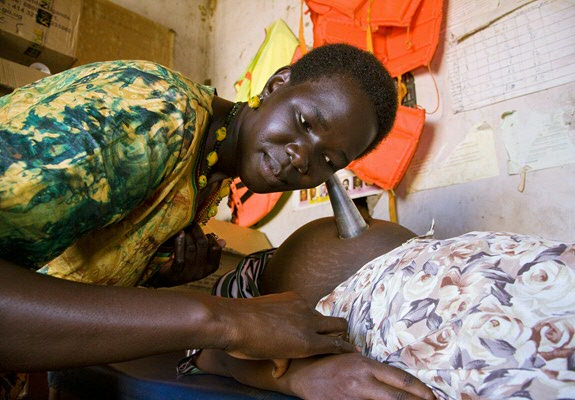Why do we have more or fewer children?

Hilde Bras is one of the new Aletta Jacobs professors at the University of Groningen. She looks for explanations for demographic developments. Family relationships seem to have a significant influence.
By Martin Althof, Communication UG
How would you describe yourself as a researcher?
I see myself as a true interdisciplinary researcher, working at the crossroads of history, sociology and demography. My specialism is social science history, which uses theories and methods from the social sciences to research the past. My Aletta Jacobs chair in Economic and Social History, with a particular focus on Global Demography and Health, focuses on the global history of population and health over the last 200 years – in particular, on changing inequalities in health, mortality, birth rate, migration and family formation between individuals and groups.
What will be the main focus of your research in the coming years?
The past 150 years have brought tremendous demographic shifts. For example, in the Global North we have seen ageing populations, population shrinkage, increased divorce rates, blended families and childlessness. In the Global South, mortality rates have fallen sharply and health has improved, but birth rates are still high in some countries and social groups (especially in sub-Saharan Africa), so the population there is still growing strongly. Many of these changes have their roots in the past, in post-colonial, colonial but also pre-colonial periods. By adopting a long-term perspective, contemporary developments and inequalities can be better placed and understood.
You are particularly interested in population developments in sub-Saharan Africa. Why is that?
United Nations predictions show that there will be 4.4 billion people living in Africa by 2100. If that proves to be the case, it would mean a thirty-fold increase in the population in the space of 200 years. What are the historical roots of this huge population growth since the 1950s? And of the failure or stagnation in many countries of the third phase of the demographic transition, whereby the birth rate also declines? To what extent did colonial ‘modernization’ of, for example, health care and education lead to a decrease in mortality (especially maternal and child mortality) and to what extent were women encouraged to have more children? What were the pre-colonial regional differences in sexuality and fertility and how did these change under the influence of colonial rule? I also want to investigate the extent to which gender inequality may explain the delayed decline in the birth rate in this region. From research in Europe and Asia, we know that women’s level of education is a good predictor of a drop in the birth rate.

You led the Vidi project ‘The power of the family. Family influences on long-term fertility decline in Europe, 1850-2010’. Why is this research so relevant?
Since 1850, the number of children in families has fallen sharply in most European countries. Various explanations have been put forward. One explanation, for example, is the Industrial Revolution. Education then became important for the labour process, but education costs money. Children therefore became more expensive, so many parents decided to have fewer children. Another explanation focuses on secularization and individualization, which led to smaller families. But those theories do not explain the regional differences in the decline in birth rates. We looked at the influence of family relationships. Family relationships and the role of relatives and non-relatives differ greatly between regions. For example, research into the Netherlands between 1870-1940 highlights the central role of women (and women’s family relationships) in negotiating procreation within households. Factors that play a role here are the availability of economic resources and the need for care within the family. But in Ukraine in the 1950s and 1960s, becoming a parent was determined by social pressure from parents (and parents-in-law), from whom couples expected to receive financial and care support.
What can Europe learn from this?
Findings vary from region to region. Future demographic changes, but also health behaviours (e.g. the spread and handling of COVID-19) are partly linked to the values, norms and practices surrounding family relationships in historically and geographically embedded family systems. Policymakers should pay more attention to these underlying value systems.
What can be said about the situation in the Netherlands?
Compared with the rest of Europe, the Netherlands had a relatively late fertility decline, which only started at the end of the nineteenth century. In almost all regions of the Netherlands, fertility has now fallen below the replacement level. There are still some areas and groups where you find larger families, such as in places along the Bible Belt, that mainly belong to the Dutch Reformed church and have traditional family values. For example, in Urk, where 44% of mothers have four or more children. Around 1950, the number of births per thousand inhabitants in North Brabant and Limburg was about 25% higher than in Groningen and Friesland. But today, this north-south divide has disappeared; Limburg and Groningen are the least fertile provinces. The provinces of Flevoland, Drenthe, Friesland and Overijssel now have a higher rate of fertility. Flevoland has the highest proportion of young people. And that’s not solely due to births; migration has also played a role. Some places are attractive to young families, often due to the availability of housing.
What can you say about the development of fertility in the Netherlands over the next 30 years?
Whether fertility will increase again (as it has in some Scandinavian countries) depends very much on the level of facilities (childcare, parental leave, etc.). The future role of the father (of the child) is also crucial here. To what extent will he be able to take care of the child and will there be a more equal division of work and care within couples? And to what extent will a caring father also be considered normal by society? Grandparents are also a key factor; they are now living healthier for longer, so can play a role in caring for grandchildren.
Might the research results be of interest to policymakers in the Netherlands?
Our results indicate that a relational perspective, focusing on family relationships and influences in particular, is needed to regulate issues of fertility decline and ageing in European societies. They also suggest that such policies should be context-specific, as family influences vary widely across regions. Policies ought to pay more attention to and respond to long-standing norms, values and practices regarding (the role of) family and relatives.
More information
More news
-
16 December 2025
How AI can help people with language impairments find their speech
-
18 November 2025
What about the wife beater? How language reinforces harmful ideas
-
03 November 2025
Menopause in perspective: How the media influences our perception
